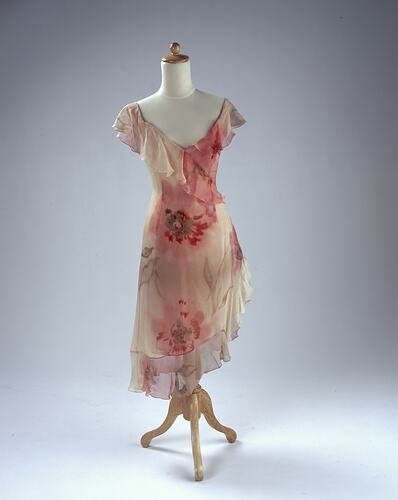Designer Richard Tyler was born in the Melbourne suburb of Sunshine on 22 September, 1946. His mother, Topsie Tyler, was a renowned seamstress, specialising in wedding dresses and theatrical attire (including costumes for the Tivoli Theatre and various ballet and dance companies.) Tyler learned the craft from his mother, and attributes his tailoring skills and attention to detail to his mother's influence. An infrequent school attendee, Tyler spent his days visiting the cinema (where he gained his love of the style and glamour of Hollywood) and wandering the streets of Melbourne, imagining one day that his own creations would be on display in the exclusive boutiques of Collins Street.
Leaving School at 15, he found employment as a pattern cutter, first for women's lingerie, then on shirts at Gloweave. At 21 he opened a shop called 'Zippity Doo Da' in Toorak Road (later renamed 'Quinzy's'), and almost immediately attracted the attention of the young hip 'monied' crowd, including rock stars such as The Bee Gees, John Paul Young, Dragon and Sherbert. He made outfits for Countdown Host Molly Meldrum, who recalled Tyler as 'shy and introverted, but an amazing worker, with an amazing attention to detail.'
By the mid 1970s, the shop sent Tyler broke; this was followed by the loss of both his parents. Disillusioned, Tyler spent the next ten years living a nomadic life in Australia, Norway and the USA, and touring with musicians such as Diana Ross, Elton John and The Village People. He finally settled in Los Angeles, after meeting his future wife Lisa Trafficante. They opened a boutique, 'Tyler-Trafficante' in 1988 (with Richard designing and Lisa taking care of the business side). Its reputation spread quickly, and within 3 years the turnover was $8 million, as they dressed Hollywood's A-List (including an array of Oscar and Emmy Award outfits.)
In 1993, he presented his first runway show in New York, going on to win the Best New Talent Award. This was followed by the Best Women's Wear Designer in 1994, and Best Men's Wear Designer in 1995. He spent time designing for other fashion houses, including Anne Klein and Byblos. In 1997, he released a range of both mens and womens shoes, both of which won awards.
More Information
-
Keywords
-
Localities
North Melbourne, Victoria, Australia, Sydney, New South Wales, Australia
-
Authors
-
Article types

